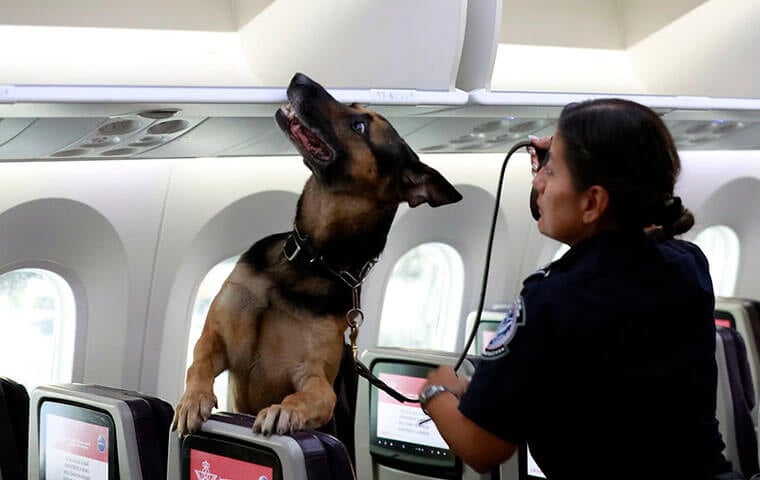 CBP, Office of Field Operations, Canine Officer at John F. Kennedy (JFK) Airport Queens, New York inspect aircraft compartments and vacated passenger areas. The AST members are trained to locate any illegal substances which may have been hidden onboard by passengers or employees. Image: CBP photo by Jaime Rodriguez Sr
By: FEDweek Staff
CBP, Office of Field Operations, Canine Officer at John F. Kennedy (JFK) Airport Queens, New York inspect aircraft compartments and vacated passenger areas. The AST members are trained to locate any illegal substances which may have been hidden onboard by passengers or employees. Image: CBP photo by Jaime Rodriguez Sr
By: FEDweek StaffIssues commonly arising in regarding federal employment including health care, work scheduling and retirement apply to dogs working for federal agencies as well, the GAO has found.
The GAO said that there are some 5,100 working dogs in some 40 federal programs across 11 departments and agencies—DoD, DHS and Agriculture account for more than 90 percent—and about another 400 working in contractor-managed programs. The dogs are used for purposes including detection of explosives, narcotics and foods, as well as for search and recovery and general law enforcement purposes.
The report, ordered by Congress two years ago in response to concerns about the treatment of the dogs, identified 18 issues as important to their welfare, including medication, medical records, routine care, emergency medical care, rest and length of on-duty time, retirement and medical needs after retirement.
It found that of the 40 programs operated directly by federal agencies, nine addressed all 18 of those issues and 32 addressed at least 13. All addressed routine veterinary care and all but one addressed emergency medical care, food and water, housing, retirement, and transportation.
Issues least likely to be addressed were “rest and length of on-duty time” by just 17, “abuse and neglect” by just 22. It said that agency officials involved with the programs said that employee misconduct policies “were sufficient to address cases of abuse and neglect” and that policies did not address rest and length of on-duty time “because working dogs’ needs vary too greatly with climate, type of activity, and other factors for policy to address this issue adequately.”
However, GAO said that “without comprehensive policies, agencies cannot ensure the humane treatment and optimal performance of their working dogs or ensure that officials carry out certain actions, like retirement and euthanasia, consistently.” It said that the agencies generally agreed with its recommendations to ensure that their policies and future contracts address all 18 issues as pertinent to them.
Settlement over OPM Database Breaches Approved; Deadline ahead for Filing Claims
These Federal Workforce Proposals May Catch Ride on Defense Bill
Watch for ‘Significant’ FEHB Plan Changes, OPM Says
Enrollee Share of FEHB Premiums to Rise 8.7 Percent on Average for 2023
OPM Addresses Drivers of Premium Hikes, Upcoming Coverage Changes in FEHB
January Retirement COLA Set: 8.7 Percent for CSRS, 7.7 Percent for FERS
Leave Scheduling: Time to Use it or Lose it
Decisions on Federal Workplace Issues Remain Before Congress
See also,
Windfall Elimination Provision Getting Attention in Congress
Why Federal Employees Quit: It’s Not All about Pay
Employees Value TSP, Annuity, FEHB Most Highly, Survey Finds
FERS Retirement Planning Bundle: 2022 FERS Guide & TSP Handbook

